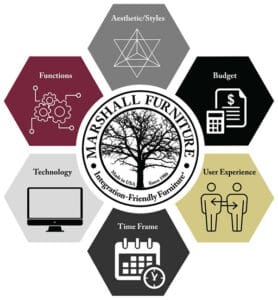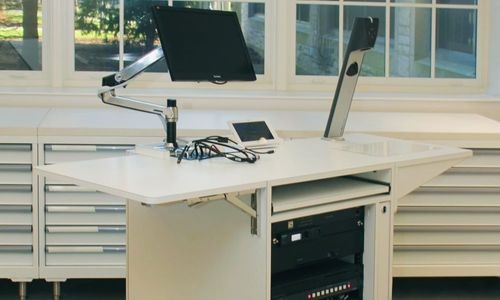When making a decision about what furniture product makes the most sense for your project, consider the outcome. Does the piece need height adjustment for varying standing positions? Will it need to match the finish or architecture of the room? Are retractable cables for easy access to cable cubbies a requirement? Does the piece need to be compact to save space? Will it arrive on time ready for install?
The look, feel and function of your AV furniture solution should always be considered for optimal performance.
Design your furniture with purpose so the deliverables are never questioned by remembering the following six principles:
#1. Function
As an AV Integrator, have you ever been asked to install gear in furniture that wasn’t designed for technology? As an end user, have you ever purchased furniture that didn’t accommodate all of your needs? We have heard this story over and over again and at times, been tasked with solving the problem after another manufacturer’s product has been delivered.
The reason for the issue is always the same: a lack of communication with the end user and/or AV integrator resulting in furniture that doesn’t fit the scope. Typically, the main hiccups are inadequate ventilation, a lack of cable pass allowance, no consideration for an AV rack, or a failure to provide ADA wheelchair accessibility. Sure, an off-the-shelf furniture solution may arrive in time for installation, but does it fit the function of the space?
Remember: when functionality is not considered, the fit fails.
#2. Aesthetics
The last thing you want in a corporate, government, judicial or higher ed setting is for your technical furniture to stand out like a sore thumb. Your AV furniture solution should act as the focal point of the room, a conduit for learning and collaboration. Why spend the time designing an AV system only to short-change the look of the product that will house it? Working with a furniture vendor that incorporates your finish and style options can prevent this mistake.
Remember: prevent the faux pas and stay in style.
#3. Budget
A word of advice – determine the budget in the early phases of the proposal. In the end, it saves money! If you’re a designer or salesperson, this is no secret. Oftentimes, endless hours are spent preparing concept drawings and pricing for proposals only to learn, upon delivery, that the client is not a fan of the price tag.
 So, how exactly does outlining the budget so early in the process save money when none has been spent yet? First, a number goal allows the designer or engineer to put detail and effort into the right design, resulting in efficient time spent on the proposal.
So, how exactly does outlining the budget so early in the process save money when none has been spent yet? First, a number goal allows the designer or engineer to put detail and effort into the right design, resulting in efficient time spent on the proposal.
Second, budget transparency will enable the vendor to offer specific furniture solutions to meet the proposal or value-engineer a solution if the proposal is complete but not within the customer’s spending limit.
Third, the user is presented with ideas and concepts that fit their budget without wasting time. Otherwise, after all, is said and done, they may feel the need to find another vendor or start from scratch. Deter- mining the budget in advance results in design proposals that are tailor-made around the client’s monetary needs.
Remember: wasting time is wasting money.
#4. User Experience
Regardless of the application, technical furniture that provides the best user experience is universal. Many professions use technology furniture daily and rely on it for presentation, instruction, videoconferencing or group collaboration. Often individuals have never used the furniture or space before, so their success hinges on how intuitive the setup is. Other times, the user has experience with the furniture and the room and has an expectation for how it should work.
Why is user experience important? From doctors and lawyers to professors, operators and coaches, they are the conductor of the space and need the furniture to be comfortable, ergonomic, understandable and accessible to use. It’s futile to spend time designing the right solution if the user and their input aren’t included in its ultimate functionality. It is important to work with a vendor that can provide deliverables that meet the various demands of the user. These include height adjustment for a specific user or group, ADA wheelchair accommodations and left or right-handed orientations. It’s important to remember that all users have individual preferences and expectations to be met to perform their tasks.
Remember: UX=XO.
#5. Technology
Presentations today tend to rely heavily on technology and audiovisual equipment. When speaking, the guest needs to be heard clearly by the entire audience. To make their point, the presenter needs to be able to show digital content to the group. Sometimes, a videoconferencing system is required to collaborate with remote team members. In a judicial setting, digital evidence needs to be displayed in court to make a case. Other times, a flight pattern needs to be observed in the control room. Whatever your profession, technology is assisting our presentations, meetings, and instructions in various ways.
Each space has its unique system requirements. Considering the technology specifications and how the AV system will be installed in the room is a critical step in the design process.
Remember: check the spec for the tech.
#6. Time Frame
In the world of AV technology furniture, the vendor is often contacted at the last minute or near the project’s end. It’s never fun to discover right before your room goes live that the lectern didn’t get ordered or that the furniture manufacturer promised a delivery date that is now delayed.
Working on a design proposal with a manufacturer that delivers on the promise is the key to a successful relationship. Knowing the project timelines and install dates and communicating with them ahead of project completion will help the vendor provide you with the right product options to deliver on time.
Further, Marshall Furniture ships almost all products fully assembled. Can you imagine going through all the trouble of acquiring a furniture item within a deadline only to discover you now need to allot additional time and resources to put it together? Marshall Furniture’s custom-built pieces are designed to be ready for use to ensure a seamless experience from start to finish.
Remember: timing is everything. Don’t settle, start planning now!










